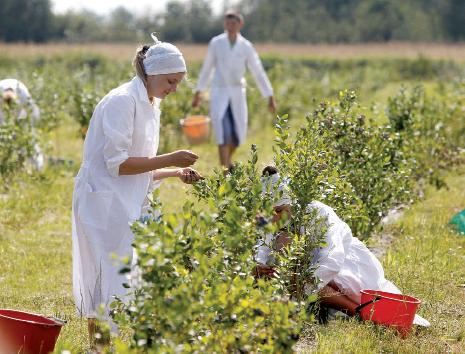Earlier, the garden blueberry was cultivated just by scientists at test stations and by some summer residents. But some, who have studied the subtleties of the ‘behaviour’ of blueberry on domestic soil, are now allocating large areas for its cultivation in order to receive a rich harvest.

Polesskie Zhuraviny JSC among leaders in blueberry storage
Several years ago, it was possible to see imported, mainly frozen, blueberries on our counters, but recently, the Belarusian blueberry has appeared on sale. Apparently, our consumers have already tried this sweet berry and demand for it frequently outstrips the supply. When we grow even more, we will satisfy the requirements of not only our citizens, but we will also start to sell them abroad.
This summer, the enterprises of consumer co-operation have prepared 9 tonnes of woodland blueberry. However, it is a bit less than last year. Spring frosts and the hot, dry weather at the end of July and the beginning of August, meant a slight shortfall in the crop. This wild-growing berry was sold fresh in consumer co-operation shops and a fifth was sent to processing enterprises, where they produced peeled blueberry with sugar and blueberry nectar.
Some agricultural production cooperatives and farms have already started in the blueberry business. And now, across Belarus, the valuable berry is grown on more than 500 hectares, while four years ago, it occupied the five times less. The Brest Region is the most successful in this business — the agricultural enterprises of the Pinsk District allocate about 100 hectares for blueberries. The Gantsevichi District is in second place, but here farmers are basically engaged in its cultivation.
The Candidate of Agricultural Sciences, Nikolay Ruban, started to cultivate blueberry in the late nineties. Before making his own garden, he went to Germany to gain experience. Today, the Blue Bird Farm, under the direction of Nikolay Nikolaevich’s son Yevgeny, is one of the largest in the Gantsevichi District. Blueberry plantations occupy more than 40 hectares here. If at first it was difficult to find a market, then now, only deliveries are needed! In this season, 25 tonnes of blueberries were collected here. Fresh berries are delivered into the capital’s shops and, as demand for this berry grows, the farm has decided to expand its plantations, at the expense of later varieties, in order to collect blueberries during the whole of August and the beginning of September.
If we don’t grow our own berries, the people will buy imported berries as happens in Russia, the farmer is convinced, “Today, we have the possibility to deliver blueberries to the Russian market. To aid manufacturers, a programme on blueberry cultivation has been developed and has operated for several years. But we still need more logistical centres which would be engaged in export deliveries. Technical potential should also be developed. For a long time, the West has used machines for blueberry collection and farmers have sorting machines. It allows for an increase in volumes and enables it to win the market. While in our country, not every manufacturer has such techniques and basically, manual labour is used. But we cannot miss this chance, especially in the present situation in the world market. Blueberries have big economic potential and may become another berry brand of our country.
Juice, marmalade, jam, confectionery and medical products can be made from blueberry, and all these are possible for import-substituting production. It is hoped that garden blueberries will appear attractive to our manufacturers.
Alexander Veevnik, the Deputy Director of the Central Botanical Garden of the National Academy of Sciences, Candidate of Biological Sciences, “Garden blueberry is an unpretentious crop, it does not need any special conditions of cultivation. It is important to correctly choose the necessary material for cutting and to define the appropriate varieties. In Belarus, there are 14 varieties of this berry, divided into districts. All who are interested in the reception of a good harvest receive our support.”











